 Printer-friendly PDF file
Printer-friendly PDF fileWestside Observer Newspaper
November 2018 at www.WestsideObserver.com
 Printer-friendly PDF file
Printer-friendly PDF file
Westside Observer
Newspaper
November 2018 at www.WestsideObserver.com
Escalating City Emloyee Bloat: The New “$400,000+ Club”
Mayor's Patronage Nepotism Jobs Alive and Well
by Patrick Monette-Shaw
Since 2013, I have published five articles1 about the City’s growing problem of bloat in City employment. This is the sixth article in this series.
The problem keeps worsening, with the advent of a new “$400,000+ Salary Club” beginning in FY 2016–2017 during Ed Lee’s tenure, and the discovery some City employees are paid bonuses.
You have to wonder if Mayor Breed is outraged what her predecessors have done increasing the bloat.
 In my September 2017 article “Mayor’s Hiring Spree Isn’t a Black Swan Event,” I noted Wikipedia describes black swan events as a metaphor for occurrences that deviate beyond what is normally expected of a situation, are extremely difficult to predict, and come as a surprise. Black Swan events are typically random and unexpected, and considered to be outliers. They have major effects and are often inappropriately rationalized after the fact through the benefit of hindsight, as if the events could have been expected.
In my September 2017 article “Mayor’s Hiring Spree Isn’t a Black Swan Event,” I noted Wikipedia describes black swan events as a metaphor for occurrences that deviate beyond what is normally expected of a situation, are extremely difficult to predict, and come as a surprise. Black Swan events are typically random and unexpected, and considered to be outliers. They have major effects and are often inappropriately rationalized after the fact through the benefit of hindsight, as if the events could have been expected.
But Mayor Lee’s hiring binge and the major effects it has had on the City’s overall budget was not surprising or random. That binge was no Black Swan accident and should come as no surprise or shock to now-Mayor London Breed.
The Long View
I started monitoring salaries of San Francisco City employees a decade and a half ago, in 2003, when then-Supervisor Tom Ammiano raised a public stink while he was helping develop the City’s FY 2003–2004 budget that City managers earning over $90,000 salaries were a problem. Ammiano proclaimed in the media that those employees should voluntarily take a 10% pay cut to help then-Mayor Willie Brown deal with a budget deficit. Few volunteered, if any. When my then-computer died in 2007 I lost my City Controller payroll database records and research on the problem for my previous articles.
Back in 2003, there were 2,918 City employees earning over $90,000 in total pay, for a combined $314.1 million. In the fiscal year ending June 30, 2018, the number of employees earning over $90,000 soared to 18,322 employees (a 527.9 percent change increase) and reached $2.5 billion in total pay (a 697.6 percent change increase).
 When Ed Lee became mayor in January 2011 in mid-Fiscal Year 2010–2011, I began to focus on employees earning over $100,000 in total pay. Lee inherited the FY 2010–2011 budget developed by former-Mayor Gavin Newsom. Lee went on to develop and submit seven City budgets of his own between FY 2011–2012 and FY 2017–2018 before he died in December 2017. His last City budget included an eighth two-year proposed budget for FY 2018–2019.
When Ed Lee became mayor in January 2011 in mid-Fiscal Year 2010–2011, I began to focus on employees earning over $100,000 in total pay. Lee inherited the FY 2010–2011 budget developed by former-Mayor Gavin Newsom. Lee went on to develop and submit seven City budgets of his own between FY 2011–2012 and FY 2017–2018 before he died in December 2017. His last City budget included an eighth two-year proposed budget for FY 2018–2019.
This sixth-in-a-series article focuses on the budgets Lee developed, and the patronage jobs bloat he introduced.
Table 1 shows that massive bloat in the City budget in the seven budgets Lee submitted to the Board of Supervisors.
Table 1: Total City Budgets: FY 2010–2011 to FY 2018–2019

Table 1 shows the first budget Lee developed in FY 2011–2012 grew by a modest 4.1 percent change increase of just $266 million. By his seventh budget, it soared to a 68.2 percent change increase of $4.5 billion.
 That’s obviously not a Black Swan event. It was a deliberate, not “random,” pattern. There’s no basis to claim Lee’s hiring binge was a Black Swan event.
That’s obviously not a Black Swan event. It was a deliberate, not “random,” pattern. There’s no basis to claim Lee’s hiring binge was a Black Swan event.
Table 2 illustrates the number of City staff positions. [Note: The number of employees listed in the City Controller’s payroll database includes all “requisitions” for employees paid as working in authorized job classification codes. An unknown number of employee’s moonlight in multiple job classification codes. The data in Table 2 is not the total number of city employees; the data is for the number of actual staff salary requisitions.]
Table 2: Mayor Lee’s Payroll and Number of City Employees: FY 2010–2011 to 2017–2018

Table 2 shows it’s no Black Swan accident Mayor Lee added 8,288 full- and part-time employees since he took office, a 24.4 percent change increase in staff and a 43.7 percent change increase in the total City payroll, increasing the payroll by over a billion dollars during his eight-year tenure between FY 2010–2011 and FY 2017–2018.
Before Lee died on December 12, 2017, he had already submitted the first version of the City’s FY 2018–2019 budget in July 2017 as part of the City’s two-year budget planning cycle, along with his final FY 2017–2018 budget.
5,112 FTE’s and Counting
As a reminder, FTE’s — “full-time equivalent” employees — are calculated by combining multiple part-time employees into an equivalent 1.0 full-time employee. A 1.0 FTE is a full-time worker, while a 0.5 is a half-time worker. Two employees each working 20 hours per week are considered the equivalent of one employee working a 40-hour week.
 As the Westside Observer has previously noted, each year San Francisco sets its authorized FTE level of city employees by adopting both an AAO (Annual Appropriation Ordinance, also known as the City’s official budget), and an ASO (Annual Salary Ordinance), the latter of which typically sets the number of FTE’s much higher than the authorized and funded FTE’s in the City budget. The FTE’s set in the ASO aren’t funded positions, but they are available should the City adopt a budget supplemental to fund the additional positions.
As the Westside Observer has previously noted, each year San Francisco sets its authorized FTE level of city employees by adopting both an AAO (Annual Appropriation Ordinance, also known as the City’s official budget), and an ASO (Annual Salary Ordinance), the latter of which typically sets the number of FTE’s much higher than the authorized and funded FTE’s in the City budget. The FTE’s set in the ASO aren’t funded positions, but they are available should the City adopt a budget supplemental to fund the additional positions.
Table 3 below also shows that during Lee’s tenure, the 8,288 new full- and part-time employees pushed the total number of City employees from 33,983 to 42,271 employees on the payroll he had first inherited.
The number of actual full- and part-time employees on the City’s payroll stands in sharp contrast to the headcounts in the AAO authorized for each fiscal year. There are fully 11,436 more full- and part-time employees (at 42,271) than the authorized FTE headcount of 30,835 in the AAO authorized for FY 2017–2018 (ending June 30, 2018), also shown in Table 3 below.
The AAO adopted for the two-year budget cycle FY 2017–2018 and FY 2018–2019 shows the authorized and proposed FTE’s on page 29. The AAO adopted for the two-year budget cycle FY 2018–2019 and FY 2019–2020 shows the authorized and proposed FTE’s also on page 29.
Table 3: FTE Counts Across Fiscal Years

 Comparing the seven-year period between FY 2011–2012 and FY 2017–2018 (ending June 30 in both ’12 and ’18), Table 3 shows:
Comparing the seven-year period between FY 2011–2012 and FY 2017–2018 (ending June 30 in both ’12 and ’18), Table 3 shows:
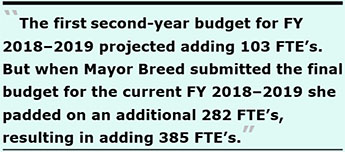 Although the FY 2017–2018 Annual Appropriations Ordinance (AAO) authorized adding 209 FTE’s, the actual number of additional full- and part-time positions added to the City Controller’s payroll database increased by 644 during the same period.
Although the FY 2017–2018 Annual Appropriations Ordinance (AAO) authorized adding 209 FTE’s, the actual number of additional full- and part-time positions added to the City Controller’s payroll database increased by 644 during the same period. In her first two-year budget for FY 18-19 and FY 19-20, Mayor Breed initially proposed adding another 359 FTE’s to her second-year budget starting 7/1/2019 in addition to the extra 385 FTE’s starting 7/1/2018. We’ll have to wait to see how much more she increases those FTE’s when the rubber hits the road in July 2019 when the final FY 2019–2020 budget is released, and how those combined at minimum 744 new FTE’s translate into another loaves and fishes miracle into more full- and part-time patronage employees in the City Controller’s payroll database.
In her first two-year budget for FY 18-19 and FY 19-20, Mayor Breed initially proposed adding another 359 FTE’s to her second-year budget starting 7/1/2019 in addition to the extra 385 FTE’s starting 7/1/2018. We’ll have to wait to see how much more she increases those FTE’s when the rubber hits the road in July 2019 when the final FY 2019–2020 budget is released, and how those combined at minimum 744 new FTE’s translate into another loaves and fishes miracle into more full- and part-time patronage employees in the City Controller’s payroll database.Table 4: Excess FTE’s Beyond AAO Authorization: FY 2017–2018 Only

A One-Year Look Back
Table 5 below shows that in the one-year period between FY 2016–2017 (ending June 30, 2017) and FY 2017–2016 (ending June 30, 2018), Mayor Lee and Mayor Breed added 644 full-and part-time employees to the payroll at an increased cost of $197.3 million, which fully 18% of the total $1 billion payroll increase since he took office in January 2011 (shown in Table 2 above).
Table 5: One-Year Increase in FTE Counts: FY 2016–2017 to FY 2017–2018

The $100,000+ Club Keeps Growing
When it comes to the obscene increase in the number of City employees earning over $100,000 annually under Mayor Lee, reasonable people may hope the famous line in Shakespeare’s play Romeo and Juliet “A rose by any other name would smell as sweet” might hold true for Lee’s hiring record.
 Unfortunately, the increase in the number of employees earning over $100,000 annually under Mayor Lee doesn’t smell “sweet,” it smells like stinky patronage hiring!
Unfortunately, the increase in the number of employees earning over $100,000 annually under Mayor Lee doesn’t smell “sweet,” it smells like stinky patronage hiring!
Figure 1 illustrates that the number of employees earning over $100,000 annually since Lee became mayor skyrocketed to 15,409 at an annual cost of $2.2 billion, a net increase of just shy of a billion dollars since he took office ($967,209,237). The Controller’s payroll database for FY 2017-2018 totaled $3.6 billion (more accurately $3,595,707,587).
Figure 1: The Growth in the “Over-$100K Club” Kept Soaring in Mayor Lee’s Tenure ( FY ’10–’11 to FY ’17–’18)

$100,000+ Club Income Inequality
It’s clear there is significant income inequality between the salaries paid to City employees. Table 6 below shows that as of June 30, 2018, 63.5% of the City’s 42,271 employees earn less than $100,000 and 36.5% earn over $100,000.
Table 6: Income Inequality of the “$100,000+ Salary Club,” Mayor Lee’s Tenure (FY ’10–’11 to FY ’17–’18)

Table 6 above shows:
 As of June 30, 2018, the 26,862 employees who earned less than $100,000 annually earned just $50,873 on average, compared to the 15,409 employees who earned over $100,000 and were paid average salaries of $144,666. Between FY 2010–2011 and FY 2017–2018, those who earned less than $100,000 saw their average salaries increase by a meager $497, while those who earn over $100,000 received $8,606 more in their average salaries.
As of June 30, 2018, the 26,862 employees who earned less than $100,000 annually earned just $50,873 on average, compared to the 15,409 employees who earned over $100,000 and were paid average salaries of $144,666. Between FY 2010–2011 and FY 2017–2018, those who earned less than $100,000 saw their average salaries increase by a meager $497, while those who earn over $100,000 received $8,606 more in their average salaries.Table 7 below shows the increases by various salary ranges of the additional 6,031 employees Mayor Lee added during his tenure earning over $100,000.
Table 7: “$100,000+ Salary Club” Percent Change Increases, Mayor Lee’s Tenure (FY ’10–’11 to FY ’17–’18)

 Table 7 illustrates:
Table 7 illustrates:
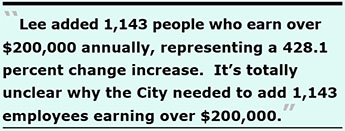 In the one-year period between FY 2016–2017 and FY 2017–2018, Lee added another 267 employees earning over $200,000, a 24.2 percent change increase in a single year.
In the one-year period between FY 2016–2017 and FY 2017–2018, Lee added another 267 employees earning over $200,000, a 24.2 percent change increase in a single year.Taking a longer two-year look back to FY 2008-2009, matters worsen. Adjusting the reporting period to two years earlier than Mayor Lee’s tenure, comparing the ten-year period between FY ’08-’09 and FY ’17-’18 (ending June 30 in both ’09 and ’18):
Table 8: “$100,000 Salary Club” Percent Change Increases, Ten-Year Lookback (FY ’08–’09 to FY ’17–’18)

 Table 8 shows:
Table 8 shows:
 increase. Their total pay (including base + overtime + “Other Pay”) jumped from $47.2 million to $322.1 million, a 583.1 percent change increase.
increase. Their total pay (including base + overtime + “Other Pay”) jumped from $47.2 million to $322.1 million, a 583.1 percent change increase.The income inequality between the various salary ranges is provided in greater detail in Table 9.
Table 9: Income Inequality of the “$100,000+ Salary Club,” FY ’17–’18 Only

 The 15,409 employees earning over $100,000 annually each averaged $144,666. The 5,472 employees who earned over $150,000 annually in total pay each averaged $185,205. In just FY 2017–2018, the 1,410 employees who earned over $200,000 each averaged $228,468 in salary.
The 15,409 employees earning over $100,000 annually each averaged $144,666. The 5,472 employees who earned over $150,000 annually in total pay each averaged $185,205. In just FY 2017–2018, the 1,410 employees who earned over $200,000 each averaged $228,468 in salary.Table 9 illustrates that the income inequality across salary ranges is breathtaking.
The New “$400,000+ Club”
 Back in FY 2008–2009, the City had zero employees listed in the City Controller’s payroll database who earned over $400,000 in total pay. Two years later, when Lee inherited former-Mayor Newsom’s final budget for FY 2010–2011, there were also zero employees who earned over $400,000 in total pay.
Back in FY 2008–2009, the City had zero employees listed in the City Controller’s payroll database who earned over $400,000 in total pay. Two years later, when Lee inherited former-Mayor Newsom’s final budget for FY 2010–2011, there were also zero employees who earned over $400,000 in total pay.
By FY 2016–2017, Lee suddenly added three employees who earned over $400,000 in total salaries, at a cost of slightly under $1.4 million. But by FY 2017–2018, in the last City budget Lee submitted, suddenly there were nine city employees who earned over $400,000, at a cost of slightly over $4 million.
Table 10: New “$400,000+ Salary Club” Percent Change Increases, One-Year Change (FY ’16–’17 to FY ’17–’18)

Table 11 below shows more details about the “$400,000+ Club.” The data was included in the City Controller’s payroll database provided on August 3, 2018.
Table 11: The Nine-Member “$400,000+ Salary Club” (FY 2017–2018)
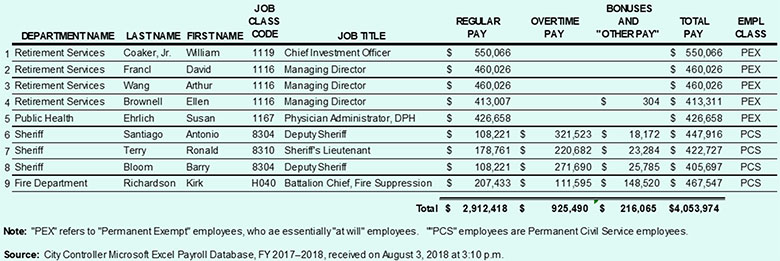
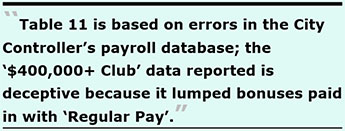 Battalion Chief Kirk Richardson’s $148,520 “Other Pay” included a $120,946 payout (81.4%) of his total “Other Pay” for accrued vacation pay, sick pay, and other “cash out” payments when he retired on May 5, 2018 just before the end of the fiscal year. The rest of his “Other Pay” was for additional retention pay and premium payments.
Battalion Chief Kirk Richardson’s $148,520 “Other Pay” included a $120,946 payout (81.4%) of his total “Other Pay” for accrued vacation pay, sick pay, and other “cash out” payments when he retired on May 5, 2018 just before the end of the fiscal year. The rest of his “Other Pay” was for additional retention pay and premium payments.Table 11 is based on errors in the City Controller’s payroll database; the “$400,000+ Club” data reported is deceptive because it lumped bonuses paid in with “Regular Pay.”
Discovery Some City Employees Earn Bonuses
 In previous articles in this series, I was unaware the City awards bonuses to some city employees.
In previous articles in this series, I was unaware the City awards bonuses to some city employees.
While researching and writing this article, I set out to estimate how much SFERS’ employees Bill Coaker and David Francl may have earned in base pay raises starting on July 1, 2018. Quite accidentally and unexpectedly, I learned of the City’s bonus payments.
On September 21, I placed a records request to the Controller’s Office to obtain the gross pay paid to Coaker and Francl on the August 21, 2018 pay date for the pay period ending August 10, 2018. I assumed I would be able to calculate raises beginning July 1, 2018 to their “Regular Pay” and “Total Pay.”
 However, given the gross pay data provided by the Controller’s Office on August 24, I calculated that the two men had perhaps taken pay cuts between FY 2017–2018 (ending 6/30/2018) and FY 2018–2019. I placed another records request on the same date asking whether they had taken pay cuts or had somehow earned bonuses in FY 2017–2018, and that’s when I learned unexpectedly also on August 24 from the Controllers’ Office that both men had been awarded “discretionary bonuses” in FY 2017–2018 by the Retirement system that was not considered part of their normal wages or salaries, even though the City Controller had initially reported on August 3, 2018 that their “total pay” was all “Regular Pay” (i.e., base wages).
However, given the gross pay data provided by the Controller’s Office on August 24, I calculated that the two men had perhaps taken pay cuts between FY 2017–2018 (ending 6/30/2018) and FY 2018–2019. I placed another records request on the same date asking whether they had taken pay cuts or had somehow earned bonuses in FY 2017–2018, and that’s when I learned unexpectedly also on August 24 from the Controllers’ Office that both men had been awarded “discretionary bonuses” in FY 2017–2018 by the Retirement system that was not considered part of their normal wages or salaries, even though the City Controller had initially reported on August 3, 2018 that their “total pay” was all “Regular Pay” (i.e., base wages).
 The Controller’s Office then provided a day later on August 25 the breakout for both men for “Regular Pay” (Base Pay) and “Other Pay” for their bonuses, shown in Table 12 below, reducing the amount of “Regular Pay” by accurately reporting bonus pay as “Other Pay.”
The Controller’s Office then provided a day later on August 25 the breakout for both men for “Regular Pay” (Base Pay) and “Other Pay” for their bonuses, shown in Table 12 below, reducing the amount of “Regular Pay” by accurately reporting bonus pay as “Other Pay.”
As of October 31, the City Controller’s Office has not explained yet what the coding problems are that it has with reporting bonuses accurately as “Other Pay,” rather than wrongly lumping bonuses in with “Regular Pay” in its annual payroll database reports.
Bonuses Paid to San Francisco Employees’ Retirement System (SFERS) Employees
Table 12 shows that of the nine employees in the “$400,000+ Club” as of June 30, 2018, four of them are employed by the San Francisco Employees’ Retirement System (SFERS):
Table 12: SFERS’s “$400,000+ Salary Club” Employees (FY 2017–2018)


Table 12 shows that of SFERS’ four employees in the “$400,000+ Club”:
 Adding in the bonus paid to Diane Chui-Justen, the bonuses paid to these five SFERS employees is well over three-quarters of a million dollars in bonuses alone. [Note: The City Controller’s Office reported just a $2,551 bonus was paid to Diane Chui-Justen in FY 2017–2018, but SFERS reported separately that she’s paid a bonus of $7,254 “per year.” Why the two City departments reported different bonus amounts paid to Chui-Justen isn’t known.]
Adding in the bonus paid to Diane Chui-Justen, the bonuses paid to these five SFERS employees is well over three-quarters of a million dollars in bonuses alone. [Note: The City Controller’s Office reported just a $2,551 bonus was paid to Diane Chui-Justen in FY 2017–2018, but SFERS reported separately that she’s paid a bonus of $7,254 “per year.” Why the two City departments reported different bonus amounts paid to Chui-Justen isn’t known.]  Coaker’s FY 2017–2018 $233,233 bonus on top of his base pay is 30 times higher than the $7,500 MPCC maximum threshold discussed below. Of note, Coaker’s $550,066 total pay in FY 2017–2018 made him the City’s highest-paid employee and the only member of the “$500,000+ Salary Club.”
Coaker’s FY 2017–2018 $233,233 bonus on top of his base pay is 30 times higher than the $7,500 MPCC maximum threshold discussed below. Of note, Coaker’s $550,066 total pay in FY 2017–2018 made him the City’s highest-paid employee and the only member of the “$500,000+ Salary Club.”A trusted, knowledgeable observer believes that SFERS’ Board of Trustees may have previously delegated bonus payment approval to SFERS’ executive director and the Trustees may have set “parameters” that bonuses could range from 0% to 50% of annual salary. But SFERS responded to a records request for its written bonus policy saying in response that there were “no responsive records.” It’s beyond belief that SFERS has no formal, written bonus policy, and the knowledgeable observer then noted: “I’m sure the authorization and parameters are an open-to-the-public document, but SFERS appears to have no interest in releasing such a document”!
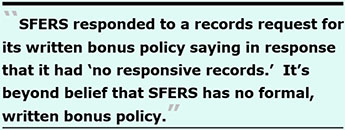 All five of the SFERS employees who received bonuses during FY 2017–2018 are represented by the Management Executive Association (MEA), and they will likely receive additional bonuses in mid-November 2018 for FY 2018–2019.
All five of the SFERS employees who received bonuses during FY 2017–2018 are represented by the Management Executive Association (MEA), and they will likely receive additional bonuses in mid-November 2018 for FY 2018–2019.
The Nebulous Criteria for Bonus Awards
Frustrated by the City Controller’s failure to answer whether employees in all City departments are eligible to receive bonuses, I turned to San Francisco’s Department of Human Resources (DHR). In response to a records request seeking 1) The City’s discretionary bonus policy and any non-discretionary bonus policy, including the maximum percentage of base salary that can be awarded as a bonus, authored by DHR or authored by any specific City Departments, and 2) Any and all labor union Memorandum of Understanding (MOU’s) describing how bonuses are awarded and how the amount of bonuses are calculated, DHR shed some additional light.
 On October 25, DHR responded indicating that only three MOU’s provide for bonus awards: The bargaining agreement with the Management Executive Association (MEA), the MEA-Police contract, and the Unrepresented Employees, who don’t have a union, but have an MOU covering senior at-will “permanent exempt” employees. No other City employees represented by approximately 33 other unions are eligible for bonus awards.
On October 25, DHR responded indicating that only three MOU’s provide for bonus awards: The bargaining agreement with the Management Executive Association (MEA), the MEA-Police contract, and the Unrepresented Employees, who don’t have a union, but have an MOU covering senior at-will “permanent exempt” employees. No other City employees represented by approximately 33 other unions are eligible for bonus awards.
 The three MOU’s who represent members eligible for bonuses include approximately 2,308 employees, 5.5% of the City’s 42,217 total employees.
The three MOU’s who represent members eligible for bonuses include approximately 2,308 employees, 5.5% of the City’s 42,217 total employees.
In addition, DHR’s October 25 records response also provided DHR’s July 16, 2018 memo sent to department heads and “appointing authorities” regarding the “MCCP Post-Appointment Compensation Adjustments” for FY 2018–2019. Since the bonus payments to SFERS employees involved FY 2017–2018, I circled back to DHR requesting the memo sent to department heads and appointing authorities in July 2017.
Both memos explicitly state that:
 Proposals for compensation adjustments and bonuses — including individual employee’s self-nominations for bonuses — are evaluated and approved by the MCCP Adjustment Committee comprised of representatives of the City Controller’s Office, DHR, and the MEA.
Proposals for compensation adjustments and bonuses — including individual employee’s self-nominations for bonuses — are evaluated and approved by the MCCP Adjustment Committee comprised of representatives of the City Controller’s Office, DHR, and the MEA. Although the word pensionable typically applies only to fixed like salaries and wages, the word typically excludes variable amounts such as commissions and bonuses, DHR’s memos indicate the MCCP bonuses are pensionable. So, the bonuses paid will be the gift that keeps on compounding and giving, long after retirement.
Although the word pensionable typically applies only to fixed like salaries and wages, the word typically excludes variable amounts such as commissions and bonuses, DHR’s memos indicate the MCCP bonuses are pensionable. So, the bonuses paid will be the gift that keeps on compounding and giving, long after retirement.The July 2017 memo lays out the amount each City department was allowed to award in FY 2017–2018:
Table 13: MCCP Post-Appointment Compensation Adjustments (FY17-18)

 Table 13 shows the Retirement System’s (SFERS) MCCP employees would receive a pool of $52,000 for the wage increases and one-time bonuses. However:
Table 13 shows the Retirement System’s (SFERS) MCCP employees would receive a pool of $52,000 for the wage increases and one-time bonuses. However:
 The $223,233 bonus paid to Coaker involved a 3,076.3% percent change increase over the $7,500 per-person maximum allowed under DHR’s MCCP guidance.
The $223,233 bonus paid to Coaker involved a 3,076.3% percent change increase over the $7,500 per-person maximum allowed under DHR’s MCCP guidance.Responding to a follow-up records request, DHR acknowledged on October 29 that:
 Department Heads, Appointing Authorities, City Departments, and Board and Commissions overseeing City departments are not allowed to increase discretionary bonuses above the $7,500-per-employee maximum for bonuses plus on-going wage increases threshold.
Department Heads, Appointing Authorities, City Departments, and Board and Commissions overseeing City departments are not allowed to increase discretionary bonuses above the $7,500-per-employee maximum for bonuses plus on-going wage increases threshold.In both memos, DHR directed each City Department Head and Appointing Authorities that they should notify their MCCP-covered MEA members “as soon as possible” of their departmental internal process and the criteria that would be applied when deciding what salary and bonus adjustments to make, including notify employees that they could self-nominate. In response to a records request placed with SFERS, SFERS notified its MCCP employees:
“While review will be primarily focused upon employee performance in Fiscal Year 2017-2018 as reflected in employee performance evaluations, additional factors such as retention, special skills, special projects, and internal equity will also be considered.”
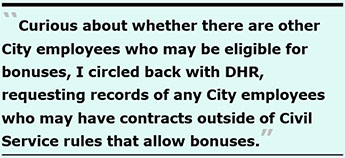 What About Employees With Contracts?
What About Employees With Contracts?
Curious about whether there are other City employees who may be eligible for bonuses, I circled back with DHR, requesting records of any City employees who may have contracts outside of Civil Service rules that allow bonuses. DHR responded on October 30 indicating that there are just two City departments that have contracts with just two employees.
 The San Francisco PUC’s General Manager (currently Harlan Kelly, Jr.) is also covered by an incentive compensation bonus plan in a written contract. Kelly is also not represented by the MEA.
The San Francisco PUC’s General Manager (currently Harlan Kelly, Jr.) is also covered by an incentive compensation bonus plan in a written contract. Kelly is also not represented by the MEA. It appears that only these two City departments — the MTA and the PUC — are allowed under the City Charter to issue employment contracts that provide for bonus compensation. No other City departments are allowed to issue employment contracts permitting bonus payments (because they don't have such authority granted to them by the City Charter). All other bonuses awarded to City employees are governed by the MCCP compensation plan.
It appears that only these two City departments — the MTA and the PUC — are allowed under the City Charter to issue employment contracts that provide for bonus compensation. No other City departments are allowed to issue employment contracts permitting bonus payments (because they don't have such authority granted to them by the City Charter). All other bonuses awarded to City employees are governed by the MCCP compensation plan.
It appears SFERS’ employees do not have contracts that permit bonuses above and beyond the MCCP plan. So just how did Messrs. Coaker, Wang, and Francl, and Ms. Brownell each receive bonuses of $163,767 to $223,223? How and when did SFERS gain the authority to use the loaves and fishes miracle to award bonuses above the $7,500 per-employee maximum threshold for these four employees?
The total amount of bonuses paid during FY 2017–2018 is not yet known. The City Controller has delayed responding to that records request until November 9. Watch this space for an update of total bonuses paid.
What’s Nepotism Got to Do With All of This?
To understand how Mayor Lee may have managed to hire 8,288 additional employees during his tenure, one explanation may involve nepotism.
 For instance, while I was a city employee I was assigned to be a “work coordinator” for a young woman who was hired as a job classification code 1426 Senior Clerk simply because her mother worked in the same City department. The young girl had no clerical experience whatsoever and would only show up for work when she couldn’t land on-call day work at another City department that paid her more per hour.
For instance, while I was a city employee I was assigned to be a “work coordinator” for a young woman who was hired as a job classification code 1426 Senior Clerk simply because her mother worked in the same City department. The young girl had no clerical experience whatsoever and would only show up for work when she couldn’t land on-call day work at another City department that paid her more per hour.
I documented her history of cheating on her time sheet, which human resources and legal professionals refer to as “theft of time,” meaning claiming hours worked that weren’t put in. I eventually submitted a memo to my own supervisor — who approved the young woman’s time card — documenting how she was stealing from the City. His reaction was to scold me saying he was “disappointed” I had written him the proof he needed to get rid of her. She eventually left the department, and we began recruiting to replace her.
I also tracked for several years the theft of time by a mid-level manager, who also cheated on his time sheet by reporting days he had not worked as days he claimed he worked, and his habit of arriving late to work, and taking hour-and-a-half and two-hour lunch hours. I knew better by then to report it, knowing I would face retaliation if I did, since his boss — a Deputy Director of the Department — had evaluated him as an “outstanding manager” on his performance reviews.
Following testing exams and interviewing, my boss and I chose the most-qualified applicant to hire and were ready to extend and employment offer. Suddenly, our Department Head stepped in and awarded the job to a woman who had not applied for the posted job announcement, had not been tested or interviewed, but had worked for the Department Head previously at another City department who needed a job. The second woman’s daughter — a then-recent high school graduate who also had no clerical or other work experience — was also brought on board, apparently in a nepotism two-fer. She was also not tested or interviewed. More sheer nepotism.
In addition, the same Department Head promoted a friend of her daughter’s to a cushy public relations job as a 0931Manager I, who was paid $128,971 in FY 2017–2018, simply because she was a friend of the family. The manager was a complete joke, and totally inept. To her credit, she did know how to use social media, as if that’s a qualification.
Then there’s the story of another nepotism new-hire in a different City department.
 Despite Civil Service rules involving testing and Civil Service Rules of the List for eligible applicants, there was another case in another department of no testing of any kind. An Assistant Department Director hired her niece — a recent college graduate with no office skills and whose only experience with the City had been as a lifeguard one summer — who was placed in an 1840 Junior Management Assistant position at $31 an hour for a summer. When the department had a vacancy for a 1426 Senior Clerk due to retirement, the department didn’t hire a replacement 1426. Instead, the summer-hire niece 1840 Management Assignment was re-assigned to support the department’s staff. The same Assistant Director also slid her daughter’s boyfriend into a similar position, where he may still be employed.
Despite Civil Service rules involving testing and Civil Service Rules of the List for eligible applicants, there was another case in another department of no testing of any kind. An Assistant Department Director hired her niece — a recent college graduate with no office skills and whose only experience with the City had been as a lifeguard one summer — who was placed in an 1840 Junior Management Assistant position at $31 an hour for a summer. When the department had a vacancy for a 1426 Senior Clerk due to retirement, the department didn’t hire a replacement 1426. Instead, the summer-hire niece 1840 Management Assignment was re-assigned to support the department’s staff. The same Assistant Director also slid her daughter’s boyfriend into a similar position, where he may still be employed.
There were no tests for either the niece or the boyfriend. Nor was there a hiring interview panel. While lists containing hundreds of eligible qualified applicants waiting to be hired were allowed to expire, family members gained city employment.
Nepotism is endemic in every City department. Just ask City employees who know blatant nepotism occurs.
Mayor’s Willie Brown, Gavin Newsom, and Ed Lee all knew this, and now so does Mayor Breed.
Where Are the Auditors?
As the Westside Observer reported in “Who’s Auditing Mayor’s Hiring Binge” in February 2017, it doesn’t appear either the Board of Supervisors or the City Services Auditor unit within the City Controller’s Office are 8yuinterested in auditing the bloat of City employees during Ed Lee’s watch as mayor. Taxpayers deserve an such an audit.
Monette-Shaw is a columnist for San Francisco’s Westside Observer newspaper, and a member of the California First Amendment Coalition (FAC) and the ACLU. He operates stopLHHdownsize.com. Contact him at monette-shaw@westsideobserver.com.
__________________
1“Voracious Management Salaries Rob City’s Lowest-Paid” (March 2013), “Mayor’s Hiring Binge vs. Retiree Pensions” (March 2016), “Mayor Ed Lee’s Five-and-a-Half Year Hiring Binge” (September 2016), “Who?’s Auditing Mayor’s Hiring Binge?” (February 2017), and “Mayor’s Hiring Spree Isn’t a Black Swan Event” (September 2017).
Postscript: When is “Incentive Pay” Not a “Bonus”?
Writing for this article was completed on October 31, but while re-formatting it to upload and post on the Internet, the San Francisco Employees’ Retirement System (SFERS) finally coughed up a potentially related public record.
Since October 23, SFERS has denied it has a formal written policy to pay bonuses. But on November 2, SFERS  presented its proposed budget for FY 2018–2019 to SFERS’ Board of Trustees on March 14, 2018 that shows on pages 32 and 34 that in FY 2017–2018 ending 6/30/18 SFERS had adopted a budget including $1,785,437 million in “incentive pay,” which SFERS creatively refers to as “incentive pay retroactive salaries,” as if incentive pay is somehow not a bonus, but salary instead. That amount is being increased in FY 2018–2019 (ending 6/30/19) to a budget of $2 million for “incentive pay.”
presented its proposed budget for FY 2018–2019 to SFERS’ Board of Trustees on March 14, 2018 that shows on pages 32 and 34 that in FY 2017–2018 ending 6/30/18 SFERS had adopted a budget including $1,785,437 million in “incentive pay,” which SFERS creatively refers to as “incentive pay retroactive salaries,” as if incentive pay is somehow not a bonus, but salary instead. That amount is being increased in FY 2018–2019 (ending 6/30/19) to a budget of $2 million for “incentive pay.”
Oddly, of the $1.78 million in incentive pay for FY 2017–2018, Table 12 above shows that bonus payments to SFERS employees reported by the City Controller’s Office totaled just $762,906 for the same FY. So where did the additional $1 million in “incentive pay” go?
To recap this: For FY 2017–2018, DHR had notified SFERS that it could award just $52,000 under the MEA’s MCCP wage increase compensation and lump-sum bonuses plan. Instead, according to the City Controller, SFERS awarded at least $762,906 in bonuses to just five SFERs’ employees. But SFERS has not indicated yet what happened to remaining $1 million of the rest of the budgeted “incentive pay.”
Watch this space for a potential update.
Addendum
As a point of reference, Figure 1 on page 5 of this article is repeated here, showing the same data points for the period ending June 30, 2017 contrasted to the period ending June 30, 2018. The shift in the bars in the chart are alarming.
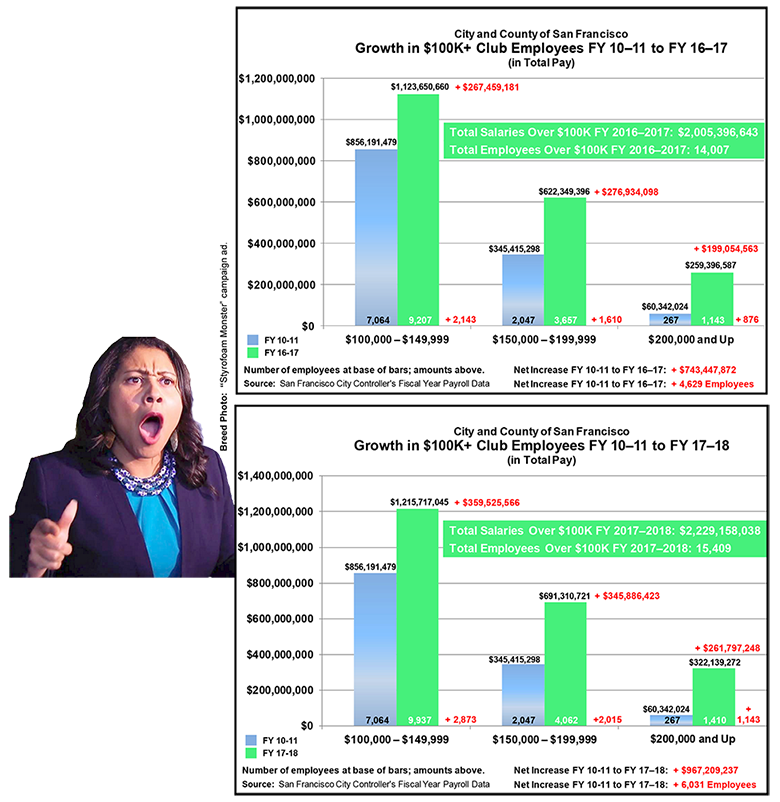
Bear in mind that Mayor Lee’s and Mayor Breed’s hiring binge won’t be over until Lee’s original term of office ends in January 2020. There will be another City budget (the final FY 2019–2020 Breed submits in July 2019) — and concomitant increases to FTE’s and total full- and part-time employees — before his original term ends.